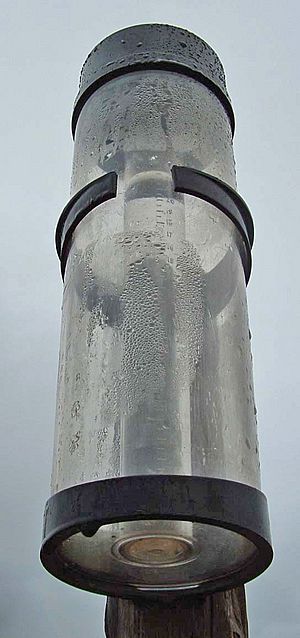Rain gauge facts for kids
A rain gauge is a cool tool that scientists called meteorologists and hydrologists use. It helps them measure how much precipitation (like rain, snow, hail, or sleet) falls in a certain area over time. Usually, it measures in millimetres. Think of it this way: one millimetre of rain collected means one litre of rain fell on every square metre of ground!
Contents
What is a Rain Gauge?
Rain gauges are important for understanding weather patterns. They help us know how much water is available for plants and rivers. They also help predict floods or droughts. Knowing how much rain falls is key for farmers and city planners.
How Do Simple Rain Gauges Work?
The most common type of rain gauge is pretty simple. It has a funnel, often made of copper or plastic. This funnel collects rainwater. The water then drips into a special bottle or cylinder below.
The gauge is placed in an open area. The top of the funnel is usually about 30 centimetres (about 1 foot) above the ground. Some gauges have marks on them so you can read the rainfall directly. For others, you might need to do a quick calculation. You measure the water depth in the bottle and use the funnel's size to figure out the total rainfall.
How Do Automatic Rain Gauges Work?
There are also "autographic" rain gauges. These are super cool because they record the rainfall all by themselves! They can be one of two types: the tilting-siphon type or the tipping-bucket type.
Tilting-Siphon Rain Gauges
In a tilting-siphon rain gauge, the rainwater collects in a special container. As the water fills up, a float inside the container rises. A pen is attached to this float. The pen draws a continuous line on a paper chart. This chart is wrapped around a drum that slowly spins, usually once a day, thanks to a clockwork motor. This way, you get a detailed record of when and how much rain fell.
Tipping-Bucket Rain Gauges
The tipping-bucket rain gauge is another clever automatic type. It has two small buckets that sit on a pivot, like a seesaw. When one bucket collects a tiny amount of rain (like 0.2 or 0.5 millimetres), it gets heavy. It then tips down, emptying the water. As it tips, the other bucket moves into place to start collecting rain.
Each time a bucket tips, it closes an electrical switch. This switch sends a signal to a recorder nearby. The recorder counts each "tip." This gives a very good idea of how much rain has fallen. Some even record how fast the rain is falling!
Where to Place a Rain Gauge
Choosing the right spot for a rain gauge is very important. It needs to be in a place that truly represents the rainfall for that area. This can be tricky because rain doesn't always fall evenly everywhere. Scientists try to find open spots away from tall buildings or trees. These things could block the rain from reaching the gauge.
Images for kids
-
Standard NOAA rain gauge
See also
 In Spanish: Pluviómetro para niños
In Spanish: Pluviómetro para niños










